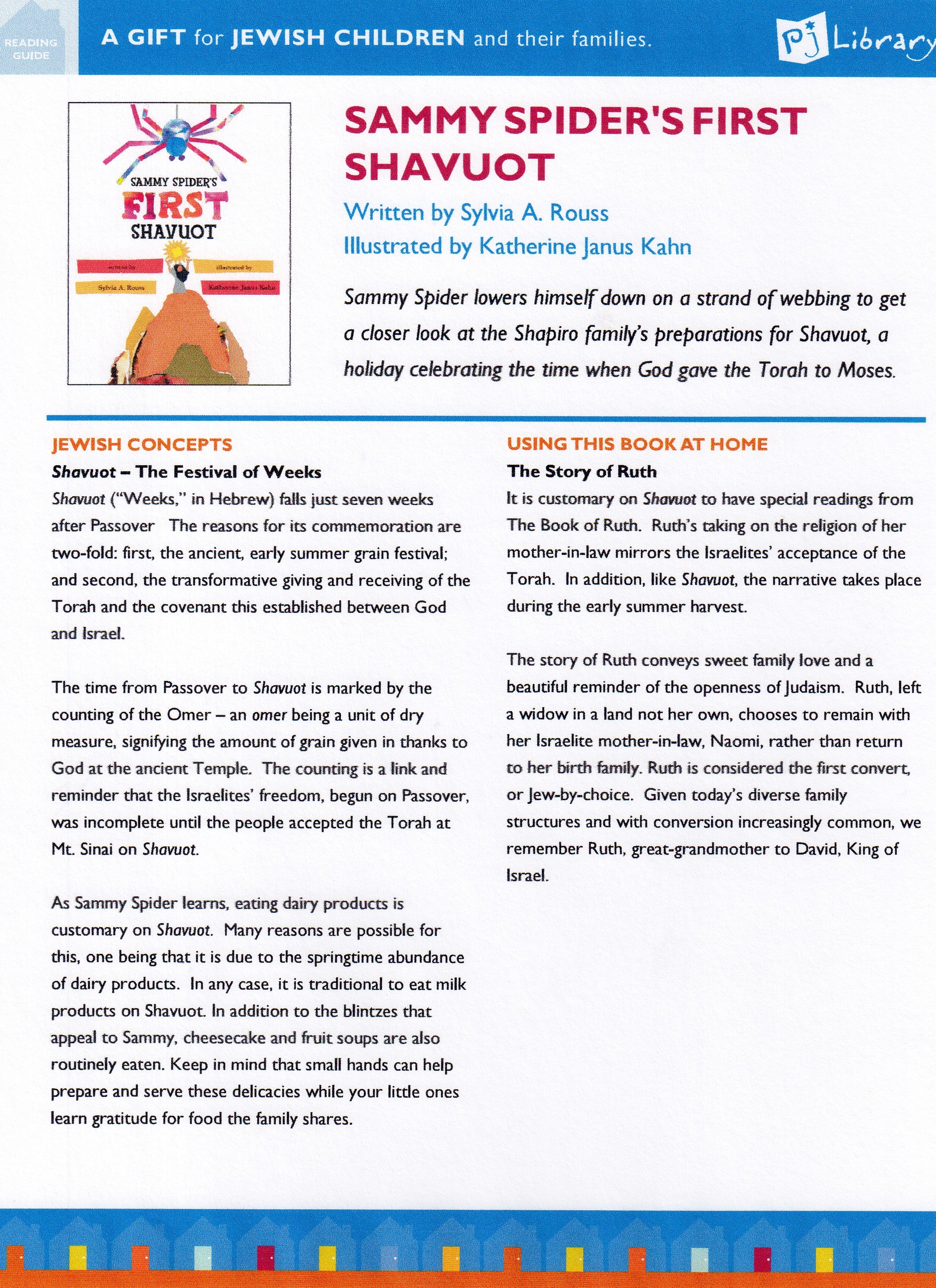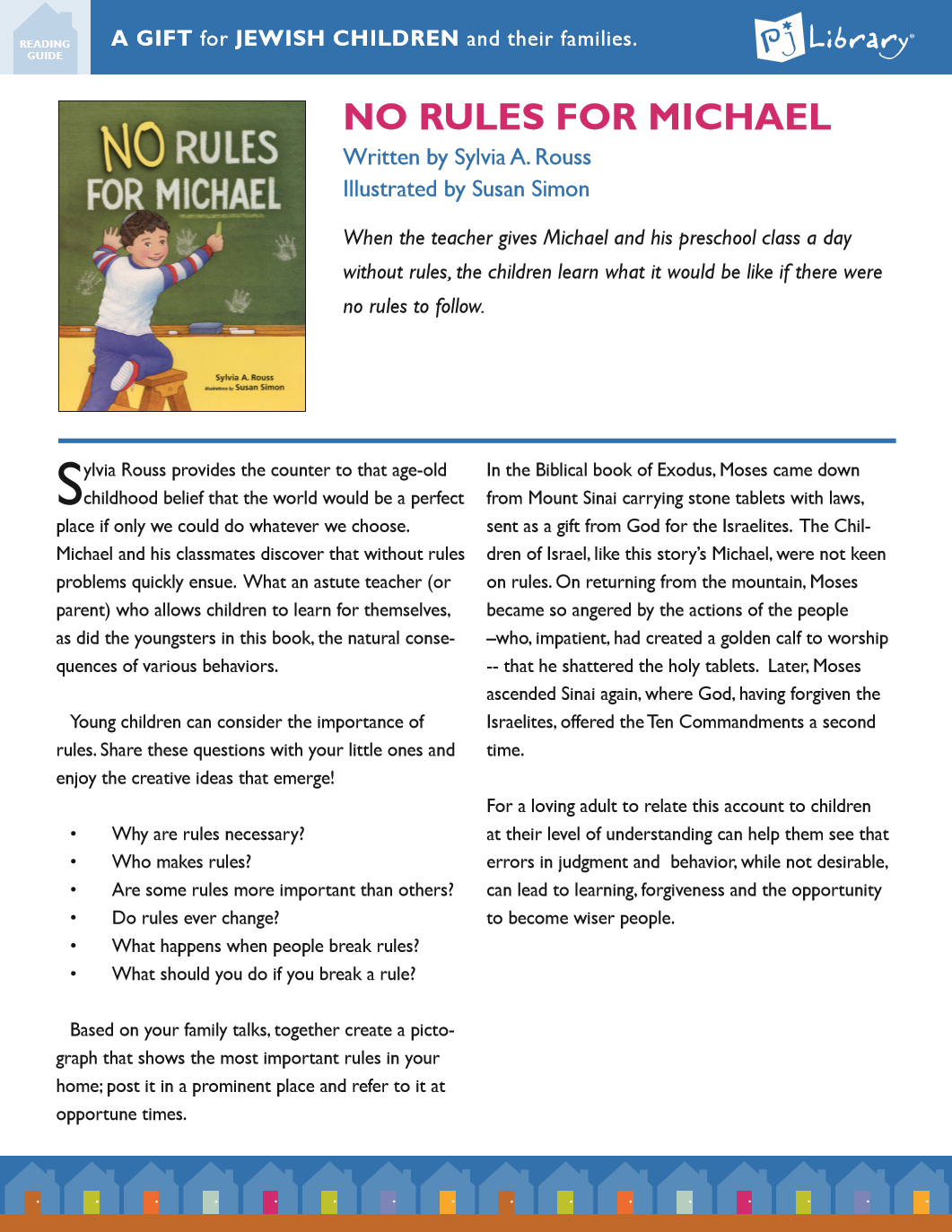Shavuot is celebrated seven weeks after Passover, usually in late May or early June when the wheat harvest ripens. Shavuot which means “weeks” is also known as the “Festival of First Fruits.” In biblical times, farmers brought bread baked from the spring wheat harvest to the Temple in Jerusalem as gifts for God. After the destruction of the Temple, this agricultural rite could no longer be observed. As a result, Shavuot also became the holiday that celebrates the giving of the Ten Commandments and the Torah to Moses on Mount Sinai. On Shavuot, synagogues are decorated with flowers and greenery. For recipes and original songs for Shavuot, click here.
 New Torah’s Lucky Day
New Torah’s Lucky Day
(Adaptation by Sylvia Rouss from the story, The Lucky Torah, by Lillian S. Freehof)
A new Torah was placed into the synagogue Ark. I’m going to like it here,” announced the new Torah as she met the three other Torahs in the Ark.
There was Big Torah, Tall Torah, and Thin Torah. “We hope you’ll be happy living in this Ark with us,” they all exclaimed.
New Torah nodded just as the doors of the Ark began to open. “There’s the Rabbi!” whispered Thin Torah.
Today is Shabbat,” Big Torah explained. “The Rabbi will take one of us out and read the week’s portion.
The Rabbi reached in and gently picked up Tall Torah and took it out of the Ark.
“He chose Tall Torah this Shabbat,” said Thin Torah.
“Oh how lucky she is!” said New Torah. “I hope I will be chosen next Shabbat.”
Every Torah is just as good as any other Torah,” said Big Torah. “It’s just luck to be chosen for a service.”
Maybe next Shabbat will be my turn,” said New Torah hopefully.
“Torah’s aren’t only read on Shabbat,” explained Thin Torah. “On every holiday the Rabbi takes one of us out to read from.”
“Maybe the Rabbi will choose me on Sukkot,” said New Torah happily.
“No,” said big Torah. “Sukkot is past, Purim is past, and Pesach is past too.”
“Oh,” thought New Torah sadly. “Maybe I’ll never be lucky.”
The next Shabbat, Big Torah was chosen by the Rabbi. The following Shabbat it was Thin Torah’s turn. New Torah was happy for her friends. How lucky they were! She
couldn’t help feeling a little sad that she had not yet been chosen for a service. Maybe she just wasn’t lucky.
A few days later all the Torahs were awakened early as the doors of the Ark were opened.
“What’s happening?” whispered New Torah.
“It’s time for Shavuot,” explained Big Torah. “Shavuot is a special holiday that celebrates the giving of the Ten Commandments to Moses on Mt. Sinai. The Rabbi will dress us in our holiday clothes. We will all wear beautiful covers.
Each Torah was taken from the Ark and dressed in white velvet covers with gold braiding. New Torah wondered which one of her friends would be the lucky Torah for the Shavuot service. Would it be Tall Torah, Thin Torah, or Big Torah? “You all look so beautiful!” she exclaimed.
New Torah listened as the Shavuot service began. She could hear the sound of music through the doors of the Ark. She felt excited for her friends as she listened to the Rabbi open the doors of the Ark. Which one of them would be the lucky Torah?
The Rabbi reached in and New Torah saw him touch Big Torah, His hands gently passed from Big Torah to New Torah. New Torah felt herself being lifted into the Rabbi’s arms.
“Look!” said Tall Torah. “The Rabbi has chosen New Torah to be the lucky Torah for Shavuot.”
“Oh, I am lucky!” cried New Torah as she stood tall and straight in the Rabbi’s arms.
“Happy Shavuot,” said Thin Torah.
“Happy Shavuot,” said Tall Torah.
“Happy Shavuot,” said Big Torah.
“Happy Shavuot to all of you,” said the Lucky New Torah.
Reviews of My Books about Shavuot
SAMMY SPIDER’S FIRST SHAVUOT — “How nice to have Sammy Spider back! In this newest addition to the Sammy Spider picture books on holidays, young readers learn about Shavuot, the holiday where God gave the Torah to Moses. As Mrs. Shapiro prepares for Shavuot by making blintzes, Sammy and his mother watch from their web on the kitchen ceiling. Mrs. Spider explains to Sammy what a recipe is, and points out that “Shavuot celebrates the first fruits of spring,” so Mr. Shapiro is preparing strawberry topping for the blintzes. When Josh bursts into the room carrying a little Torah, Rouss draws the parallel through Sammy’s discussion with his mother that, like the instructions in a recipe, the Torah contains the instructions, or rules, to become a recipe for life. She tells him “it includes the story of the Jewish people, and has rules about how to treat others with love, kindness, and respect.” Kahn’s colorful, bright paper-cut illustrations accent the text, which is age- appropriate and just right for explaining Shavuot to young children. The story ends with a concise explanation of the holiday. It notes that the meaning of Shavuot is “weeks,” so the holiday is called The Feast of Weeks, and since the words of Torah are said to be as sweet as milk and honey, it is traditional to eat dairy, such as blintzes, on Shavuot. A step-by-step recipe for blintzes is included. This is highly recommended as an addition to the very few books explaining Shavuot that are available for young readers”. (Jewish Book Council)
NO RULES FOR MICHAEL (from KarBen) — “Michael thinks school would be more fun without rules and gets his wish. But is it exactly what he was hoping for?” And, a reviewer in School library Journal wrote – “After his teacher’s lesson about the Ten Commandments and a discussion about the importance of having classroom rules, Michael decides that school would be more fun without them. Miss Sharon goes along with his request, and the children soon see the consequences of her decision. Michael is upset when a classmate takes a puzzle piece away from him and his plans to showcase his new dinosaur are thwarted because no one will listen during circle time. At recess, he never gets a turn on the tricycle, and at snack time, another student takes his crackers. Michael’s tears show his frustration and disappointment and he finally acknowledges the importance of rules. His teacher remarks instructively, “That’s why God gave us the Ten Commandments. And that’s why we have rules here at school. We need to treat others the way we want to be treated.”…”


